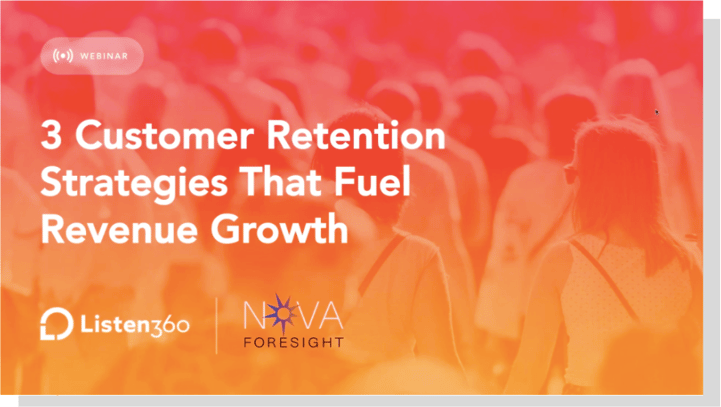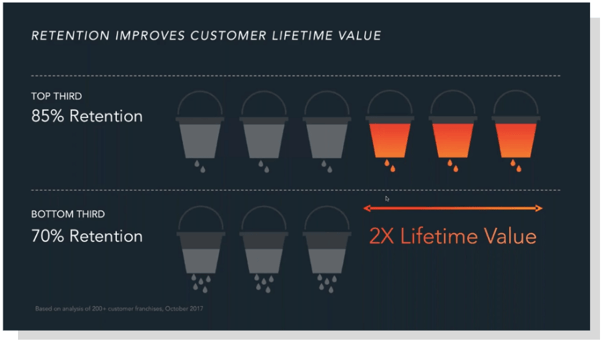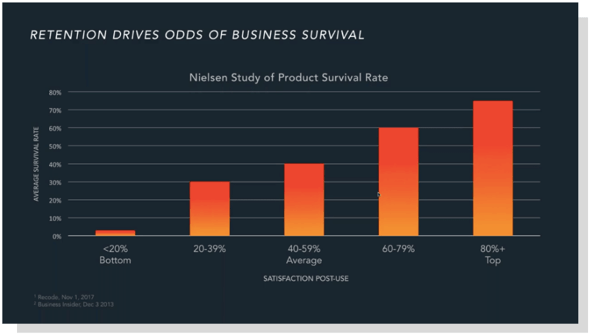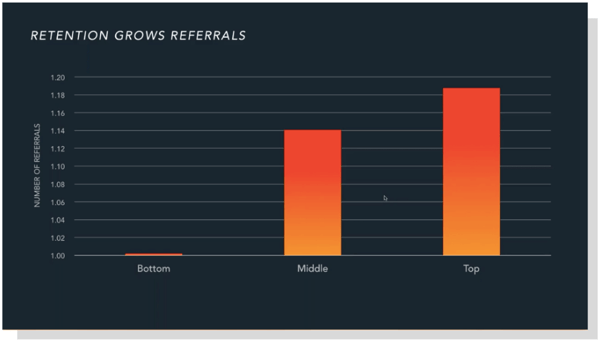
We’re happy to share content created by our partner companies. This blog summarizes one section of the recent webinar “3 Customer Retention Strategies That Fuel Revenue Growth”. The webinar was presented by Angela Bossie, Founder and President of Listen360, a customer-listening solution that helps businesses gather and analyze customer feedback, and John Schroeder, Principal for Nova Foresight, a community of executive-level consultants, leading academics, and subject-matter experts. After reading the blog please be sure to watch the full webinar for more retention insights!
We all know retention is good for business, but why exactly is that? In the webinar's first section, John Schroeder explores the impact of retention through a case study of a large lawn care franchise. Franchisees were separated into three segments based on their retention rates from highest to lowest. This data is useful because, like fitness, the lawn care market has defined seasonality and is heavily dependent on repeat customers.
Schroeder makes the business case for retention by highlighting the critical ways it drives business revenue.
Retention Drives Higher Profitability
The lawn care franchise case study found that the top third of franchisees in terms of retention were retaining 85% of their clients, or more simply, if they started with 100 clients, they would retain 85 clients by the end of the year. This is a strong retention rate for any business. However, the bottom third of franchisees in terms of retention held on to just 70% of clients.
This means bottom-performing franchisees lose double the amount of customers in the same amount of time as the top-performing franchisees. More importantly, this translates to a 20% difference in the margin of profit that the top third see compared to the bottom third.

Retention Improves Customer Lifetime Value
Retention also impacts the long-term profitability of a business by boosting the lifetime value of clients. Using the example of a business with 100 clients, Schroeder demonstrates the compounding effect that lower retention rates have on profitability year over year.
Business With 85% Retention Rate- Year 1: 100 customers
- Year 2: 85 customers
- Year 3: 72 customers
- Year 4: 61 customers
- Year 1: 100 customers
- Year 2: 70 customers
- Year 3: 49 customers
- Year 4: 34 customers
While the initial difference between an 85% retention rate and a 70% may not appear drastic, by year 4, an 85% retention rate will have retained nearly twice the amount of original clients. Top-performing franchisees will see double the lifetime value from their clients as compared to those businesses with 70% retention rates.

Retention Drives Odds of Business Survival
To show how retention influences odds of survival, Schroeder turned to the Nielsen Company, which has the largest database of consumer product launch information. Nielsen created a graph based on how satisfied customers were with a product after having the opportunity to use it. They then compared what percentage of products in each bracket survived two years or more.

The study found that the overwhelming majority of products ranked in the bottom 20% of customer satisfaction, meaning they were highly disliked by consumers, did not survive two years. While this data centers around consumer products, the success of a product, like fitness businesses, is highly dependent on repeat customers. Products that are unable to delight and retain customers quickly fail.
Retention Grows Referrals
Not only does strong retention help businesses keep more clients, but it also helps them gain new customers. To prove this, Schroeder added referral data to the lawn care franchisees case study and found the top-performers in retention rates received nearly 20% more referrals than those ranked in the bottom third.

(Middle and top bars represent the percentage increase in referrals compared to the bottom.)
Why would a business that retains more customers also receive more referrals? Simple: improved customer experience. Everything a business does to keep its current customers like exceptional service, superior products, or individual attention, will convert customers into advocates who refer friends and family to the business. Schroeder is quick to point out that "referrals are the single most effective source of new customers. People trust their friends more than digital ads.”
Now that you’ve seen the business case for retention, learn how to boost retention levels in your club. In the full webinar, Schroeder and Bossie explain how NPS scoring helps you retain more customers, how to create a feedback loop, and how to improve your customer experience through both strategic and tactical thinking.